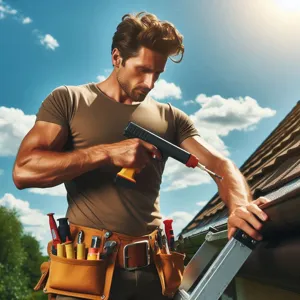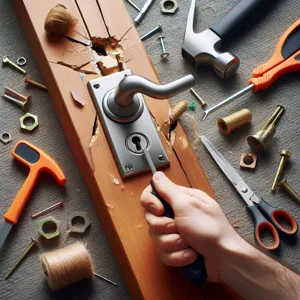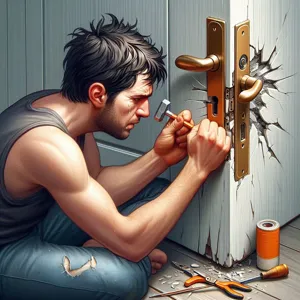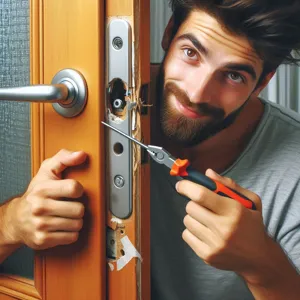A broken window pane can be more than just an eyesore; it can compromise the safety and comfort of your home.
Whether it’s a result of an unfortunate accident, a sudden storm, or simply wear and tear over time, dealing with a shattered or cracked window can feel overwhelming. But fear not! With the right tools and a little bit of guidance, you can tackle this DIY project with confidence and restore your window to its former glory. In this step-by-step guide, we’ll walk you through the essential techniques and tips that professionals use to fix broken window panes efficiently and effectively. From assessing the damage and gathering materials to executing the repair with precision, you’ll discover everything you need to know to become a home repair hero. Say goodbye to that broken pane and hello to a secure and beautifully restored window!
1. Introduction: Understanding the Importance of Window Maintenance

Windows are often the unsung heroes of our homes, quietly serving their purpose while enhancing our living spaces. They not only allow natural light to flood in and provide stunning views of the outside world, but they also play a crucial role in the overall efficiency and safety of your home. A broken window pane, however, can disrupt this balance, leading to issues such as drafts, heat loss, and even security risks.
Understanding the importance of regular window maintenance is key to ensuring that your home remains comfortable and safe. Just like any other part of your house, windows require care and attention to prevent damage and prolong their lifespan. Regular checks can help you identify minor issues before they escalate into costly repairs, saving you time and money in the long run.
Moreover, maintaining your windows enhances your home’s curb appeal and can even increase its value. A well-maintained window not only improves aesthetics but also contributes to energy efficiency, helping to lower utility bills and reduce your carbon footprint. This is especially relevant in today’s world, where eco-conscious living is more important than ever.
In this guide, we will walk you through the steps of fixing a broken window pane, equipping you with the knowledge and skills needed to tackle this task like a pro. Whether it’s a small crack or a shattered pane, with the right approach, you can restore your windows to their former glory and ensure they continue to serve your home effectively for years to come. Let’s dive in and get started!
2. Safety First: Essential Safety Gear and Precautions
When it comes to repairing a broken window pane, safety should always be your top priority. handling glass can be hazardous, and taking the right precautions can prevent injuries and ensure a smooth repair process. Start by donning essential safety gear to protect yourself from potential hazards. Here’s what you’ll need:
1. **Safety Glasses**: Protect your eyes from flying glass shards and dust. A good pair of safety glasses will shield your vision from any unexpected accidents that might occur as you work.
2. **Gloves**: Thick, cut-resistant gloves are crucial for safeguarding your hands. They will not only protect you from sharp edges but also provide a better grip on tools and materials.
3. **Dust Mask**: If you’re working with older windows, there’s a chance you may encounter lead paint or dust particles. A dust mask will help filter out harmful particles and keep your lungs safe while working.
4. **Long Sleeves and Pants**: Wearing long sleeves and pants is an effective way to cover your skin and minimize the risk of cuts. Opt for durable fabrics that can withstand minor abrasions.
5. **Closed-Toe Shoes**: Ensure you’re wearing sturdy, closed-toe shoes for added foot protection. This is especially important if you drop any glass shards or tools during the repair.
Once you’re properly equipped, make sure to clear the surrounding area of any obstacles or tripping hazards. Lay down a drop cloth or tarp to catch any debris that may fall during the repair, making cleanup easier afterward. Additionally, keep pets and young children at a safe distance from the work area to prevent accidents.
Before you begin the actual repair, take a moment to assess the situation. Look for any exposed glass or sharp edges and ensure you’re prepared to handle them carefully. By taking these essential safety measures, you’ll set the stage for a successful repair while safeguarding yourself against potential injuries. With safety as your foundation, you’re now ready to tackle the next steps in fixing that broken window pane like a pro!
3. Tools and Materials Needed for the Job
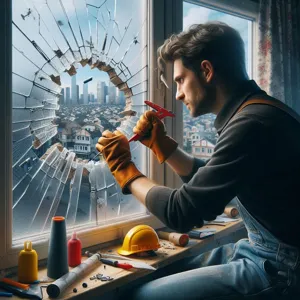
Before diving into the repair process, it’s crucial to gather all the necessary tools and materials that will help you fix your broken window pane efficiently and safely. Having everything on hand will save you time and ensure a smoother workflow. Here’s what you’ll need:
1. **Safety Gear**: First and foremost, prioritize safety. Equip yourself with safety goggles to protect your eyes from glass shards, heavy-duty gloves to shield your hands, and a dust mask to avoid inhaling any debris.
2. **Measuring Tape**: A measuring tape is essential for accurately sizing the broken pane and ensuring that your replacement glass fits perfectly into the frame.
3. **Utility Knife**: This will come in handy for cutting away any old paint or putty surrounding the broken pane, allowing for a clean removal and a smooth installation of the new glass.
4. **Putty Knife**: A putty knife is useful for applying new putty and smoothing it out once the replacement glass is in place.
5. **Replacement Glass**: Of course, you’ll need a piece of glass that matches the dimensions of your broken pane. If you’re unsure where to buy it, local hardware stores or glass supply shops are great options.
6. **Glazing Putty**: This is a crucial material for sealing the new glass into the frame. It helps to create a weather-tight seal while also providing stability.
7. **Glazing Points or Clips**: These small metal pieces are used to secure the glass in place. Depending on your window frame, you may need either glazing points or clips to hold the new pane securely.
8. **Hammer**: A hammer is necessary for gently tapping in glazing points or securing any loose components of the window frame.
9. **Caulk or Weather Stripping (Optional)**: If your window has gaps or needs extra insulation, caulk or weather stripping can help improve its energy efficiency.
Once you have all these tools and materials ready, you’ll be well-equipped to tackle your window pane repair like a true professional. Remember, preparation is half the battle, and having the right supplies at your fingertips will make the job not only easier but also more enjoyable.
4. Assessing the Damage: Identifying the Type of Break
Before you dive into repairs, it’s crucial to assess the damage thoroughly. Identifying the type of break in your window pane will help you determine the best course of action and whether you can tackle the fix yourself or if you should call in a professional.
Start by examining the glass closely. Is it a clean break, or is the glass shattered into a multitude of tiny pieces? A clean break often indicates that you can simply replace the pane, while a shattered window may require additional steps for safe removal. If the break is minor, with only a small crack or chip, you might be able to utilize a repair kit designed for glass. However, if the damage extends beyond a small area, it’s likely time for a full pane replacement.
Next, consider the frame. Is it wood, aluminum, or vinyl? Wooden frames may have warped or rotted, requiring not only a glass replacement but also some carpentry work. Aluminum frames can bend or dent, while vinyl frames are generally more durable but can still incur damage.
Don’t forget to check for any potential hazards as well. Are there sharp edges or loose shards that could pose a risk? Wearing heavy-duty gloves and safety goggles is paramount at this stage to protect yourself. By accurately assessing the type of break and the condition of the frame, you can move forward with confidence, knowing exactly what materials and tools you’ll need for your repair job. Remember, a careful evaluation now can save you time and hassle later on as you work to restore your window to its former glory.
5. Preparing the Area: Clearing the Workspace

Before you dive into the repair process, it’s essential to prepare the area where you’ll be working. A clean, organized workspace not only enhances safety but also ensures that you have everything you need within reach, making the repair go smoothly. Start by clearing away any furniture, plants, or decorations that might obstruct your access to the broken window. If you’re working indoors, consider moving items that could be inadvertently damaged by falling glass or dust.
Next, lay down a drop cloth or old newspapers beneath the window to catch any debris or shards that may fall during the repair. This will make cleanup easier and protect your flooring from scratches or stains. If you’re working outside, ensure the area is free of any clutter that could pose a tripping hazard.
Safety should always be your top priority, so don your protective gear before proceeding. Put on safety goggles to shield your eyes from sharp glass fragments and gloves to protect your hands from cuts. If the window is particularly large or high, you might also want to use a sturdy ladder for better access. By taking the time to prepare your workspace, you set the stage for a successful repair, allowing you to focus on the task at hand without distractions or safety concerns. With your area clear and organized, you’ll be ready to tackle the next steps with confidence.
6. Removing the Broken Glass: Step-by-Step Instructions
Removing the broken glass from a window pane can seem daunting, but with the right tools and a careful approach, you can tackle this task like a pro. Here’s a step-by-step guide to ensure you do it safely and effectively.
**Step 1: Gather Your Tools and Safety Gear**
Before you begin, make sure you have a few essential tools on hand: heavy-duty gloves, safety goggles, a flathead screwdriver or putty knife, pliers, and a trash bag for disposal. Wearing gloves and goggles is crucial to protect yourself from sharp glass shards.
**Step 2: Assess the Damage**
Take a moment to inspect the broken window. If there are large shards still held in place, it’s best to leave them alone for now. If the glass has shattered into smaller pieces, you may need to remove the entirety of the pane.
**Step 3: Remove Loose Glass**
Carefully clear away any loose glass from the window frame. Use your gloved hands to pick up smaller pieces, and for larger shards, gently push them towards the center of the pane with your putty knife or flathead screwdriver. This helps to minimize the risk of injury.
**Step 4: Take Out the Glazing Points**
Look for the small metal glazing points or clips that hold the glass in place. Using your flathead screwdriver, gently pry these out from the frame. Be careful not to damage the surrounding wood or material as you do this.
**Step 5: Remove the Glass Pane**
Once the glazing points are removed, it’s time to take out the broken glass pane. If the pane is still partially intact, carefully lift it out from the frame. If it’s in pieces, use your pliers to grip the edges of each shard and pull them out one by one. Make sure to dispose of these pieces in your trash bag immediately to prevent any accidents.
**Step 6: Clean the Frame**
With the broken glass removed, take a moment to clean the window frame. Use a damp cloth to wipe away any debris or glass dust. This step ensures a clean working area for your new glass pane installation.
**Step 7: Dispose of the Broken Glass Properly**
Finally, securely wrap the broken glass in newspaper or other protective material before placing it in the trash bag. This precaution prevents any injuries to you or sanitation workers who handle the waste.
By following these steps, you can safely remove a broken window pane and prepare your frame for a new installation. With patience and care, you’ll be well on your way to restoring your window to its former glory.
7. Measuring and Cutting the New Glass Pane

When it comes to replacing a broken window pane, precision is key. The seventh step in our guide, measuring and cutting the new glass pane, requires careful attention to detail to ensure a snug fit that keeps your home secure and energy-efficient.
Start by taking accurate measurements of the window frame. Use a tape measure to record the height and width of the opening, making sure to measure at multiple points, as frames can sometimes be slightly warped. Take the smallest measurement to ensure your new glass fits perfectly. It’s a good idea to jot down your measurements on a notepad or use your smartphone to avoid any mix-ups.
Once you have your dimensions, it’s time to select the right glass. Choose tempered or laminated glass for added durability, especially if the window is in a high-traffic area or if safety is a concern. With your glass type decided, head to a local hardware store or glass supplier. Many places can cut the glass to your specifications, simplifying the process. If you prefer to cut the glass yourself, make sure to pick up a glass cutter, straight edge, and safety goggles.
To cut the glass, lay it flat on a sturdy surface, ideally a workbench or table covered with a soft cloth to prevent scratches. Align your straight edge with the measurement you recorded, ensuring it is perfectly straight. With firm pressure, score the glass along the edge of the straight edge, creating a shallow incision. Remember to apply even pressure and make a single, continuous motion for the best result. Once scored, gently press down on both sides of the score line to snap the glass cleanly apart.
Finally, smooth the edges of the newly cut glass with a fine-grit sandpaper to eliminate sharp edges that could pose a hazard. With your new pane ready, you’re one step closer to restoring your window to its former glory. This critical phase of the repair not only showcases your precision but also sets the stage for a secure and visually pleasing installation.
8. Preparing the Frame for the New Glass
Before you can insert the new glass pane, it’s crucial to prepare the window frame meticulously. This step is vital to ensure a snug fit and a long-lasting repair, so let’s walk through the process.
Start by inspecting the frame for any debris, old putty, or damaged materials that might hinder the new glass from sitting properly. Carefully remove any remnants of the old glazing compound using a putty knife. Be cautious during this process—too much force can damage the frame or cause splinters. If you encounter stubborn pieces, a heat gun can help soften the putty, making it easier to scrape away.
Once the old putty is cleared, examine the frame for any imperfections or damage. If you spot any cracks or rotting wood, it’s essential to address these issues before proceeding. You can fill small cracks with wood filler and sand them down to create a smooth surface. For larger damage, you might need to replace sections of the frame or even consider a professional repair if the damage is extensive.
Next, clean the frame thoroughly to remove dust and debris. A clean surface allows for better adhesion of the new glazing. If you’re working with a wooden frame, consider applying a coat of primer to protect it from moisture and enhance the bond with the new putty.
Finally, measure the opening carefully to ensure your new glass pane fits perfectly. Take your time with this measurement—precision is key! With the frame prepped and ready, you’ll be all set for the next step: installing the new glass. This preparation not only sets the stage for a secure fit but also ensures that your window will look as good as new, maintaining both functionality and aesthetic appeal.
9. Installing the New Glass Pane: Techniques for a Secure Fit
Installing the new glass pane is a crucial step in ensuring your repair stands the test of time. With the right techniques, you can achieve a secure fit that not only enhances the aesthetic appeal of your window but also provides insulation and protection against the elements. Here’s how to do it like a pro.
**Prepare the Frame:** Before inserting the new glass, ensure the window frame is clean and free of any debris or old putty. Use a putty knife to scrape away remnants of the old glazing compound and sand down any rough edges. This creates a smooth surface for the new pane to rest against, allowing for a better seal.
**Apply a Glazing Compound:** Once the frame is prepped, it’s time to apply a bead of glazing compound. This will act as a cushion and sealant for your new glass. Using your putty knife, spread a generous yet even layer along the frame where the glass will sit. Make sure to cover the edges thoroughly, as this will help secure the glass and prevent drafts.
**Carefully Place the Glass Pane:** With the glazing compound in place, gently lift your new glass pane and position it into the frame. Take your time to ensure it’s seated evenly against the compound. It’s important to handle the glass carefully to avoid any chips or cracks during this process.
**Secure the Glass with Points:** To hold the glass in place, use glazier points—small metal tabs designed to keep the glass from shifting. Insert these points into the frame, spaced about 6 inches apart, using a putty knife or a small hammer. Press each point gently into the frame until they are flush with the surface. This will provide additional stability for the glass.
**Final Touches with Glazing Compound:** Once the glass is secured, it’s time to seal the edges. Apply another layer of glazing compound around the perimeter of the glass, ensuring it fills any gaps between the glass and the frame. Smooth it out with your putty knife for a clean finish. This not only enhances the window’s appearance but also provides insulation and protection against moisture.
**Let it Cure:** Finally, allow the glazing compound to cure according to the manufacturer’s instructions—usually a few days. During this time, avoid putting any pressure on the glass or reattaching any window hardware. This curing period is essential for achieving a solid, long-lasting repair.
By following these techniques, you’ll not only secure your new glass pane but also gain the satisfaction of completing a professional-quality repair. Whether it’s for a small crack or a complete replacement, proper installation is key to maintaining the integrity of your windows and the comfort of your home.
10. Sealing the Edges: Ensuring Weather Resistance
Sealing the edges of your newly installed window pane is a crucial step in ensuring long-lasting durability and optimal weather resistance. This final touch not only enhances the aesthetic appeal of your window but also protects your home from the elements, preventing drafts, moisture, and pests from invading your space.
Begin by selecting a high-quality weatherproof caulk suitable for your window type—silicone or polyurethane caulk are popular choices due to their flexibility and strength. Before applying, make sure the surface is clean and dry. Use a utility knife or scraper to remove any old caulk or debris from the edges of the frame, ensuring a smooth surface for adhesion.
Once prepped, cut the tip of the caulk tube at a 45-degree angle, making a small opening to control the flow. Load the caulk into a caulking gun for easier application. Start at one corner of the window and apply a continuous bead of caulk along the edges, working your way around. It’s important to maintain even pressure on the trigger to produce a consistent line of caulk.
After applying the caulk, use your finger or a caulking tool to smooth the bead, pressing it firmly into the gap between the window frame and the glass. This not only ensures a tight seal but also creates a polished finish that enhances the overall look of your window.
Allow the caulk to cure as per the manufacturer’s instructions, which typically takes 24 hours. Once it’s fully set, your window will be not only beautifully framed but also ready to withstand whatever Mother Nature throws its way. By sealing the edges effectively, you’ll enhance your home’s energy efficiency, reduce maintenance costs, and enjoy peace of mind knowing your window is protected from water infiltration and air leakage for years to come.
11. Finishing Touches: Painting and Touching Up the Frame
Once your new window pane is securely in place and the putty has dried, it’s time to turn your attention to the finishing touches that will restore your window frame to its former glory. This step not only enhances the aesthetic appeal of your window but also protects the wood from the elements.
Start by inspecting the window frame for any signs of wear and tear. If the wood has chipped or the paint has peeled, a light sanding will help create a smooth surface for painting. Use fine-grit sandpaper to gently buff any rough spots, ensuring you don’t damage the new glazing. Wipe away any dust with a damp cloth to prepare the surface for paint.
Next, select a high-quality exterior paint that matches the existing color of your window frame. If you’re feeling adventurous, this could also be the perfect opportunity to refresh the color! Using a small brush, apply a thin layer of paint to the frame, starting from the edges and working your way inward to avoid drips. Be sure to paint any corners and crevices thoroughly for a neat finish. If necessary, a second coat may be applied after the first has dried completely, providing a richer color and better protection.
For added protection against moisture, consider applying a clear sealant over the painted surface once it has dried. This will help extend the lifespan of your paint job and keep your frame looking fresh for years to come.
Finally, take a step back and admire your handiwork. The finishing touches not only complete the repair but also enhance the overall look of your home. With a little patience and attention to detail, you’ve transformed a broken window pane into a beautifully restored feature that adds character and charm to your space.
12. Cleaning Up: Proper Disposal of Broken Glass
Once you’ve successfully replaced the broken window pane and admired your handiwork, it’s time to address the remnants of your project: the shattered glass. Proper disposal of broken glass is not just a matter of convenience; it’s crucial for safety. Sharp shards can pose a serious risk, not only to you but also to anyone else who may come across them.
Start by carefully collecting the larger pieces of glass. Use a pair of sturdy gloves to protect your hands from cuts, and consider using a thick towel or a piece of cardboard to scoop up the shards. Avoid using your bare hands, as even the smallest pieces can be dangerously sharp. Place the larger glass fragments into a sturdy, puncture-resistant container—an old coffee can or a heavy-duty plastic bag works well. Seal the container tightly to prevent any accidental spills.
For the tiny slivers and dust that remain, a damp paper towel or cloth can be your best ally. Gently wipe down the area surrounding the window frame, ensuring that you capture as many of the minuscule shards as possible. Once you’ve thoroughly cleaned the area, dispose of the used paper towels in your puncture-resistant container.
To complete the cleanup, check your surrounding environment for any stray pieces of glass that may have fallen during the repair. Take a moment to scan the floor and nearby surfaces, ensuring the area is completely safe for everyone. Finally, dispose of the sealed container in accordance with your local waste management guidelines. Many municipalities have specific instructions for disposing of broken glass, so be sure to check those to avoid any penalties.
By taking the time to clean up properly, you not only enhance your own safety but also demonstrate responsibility in your DIY endeavors. With everything tidied up, you can step back and admire your finished project, knowing you handled the task like a true professional!
13. Tips for Preventing Future Breaks
Preventing future breaks in your window panes is essential not only for maintaining the aesthetic appeal of your home but also for ensuring safety and energy efficiency. Here are some practical tips that can help you safeguard your windows against potential damage:
1. **Invest in Quality Materials**: When replacing a broken pane or installing new windows, choose high-quality glass and sturdy frames. Tempered glass, for instance, is much more resistant to impact and can withstand extreme weather conditions, reducing the likelihood of future breaks.
2. **Regular Maintenance**: Make window maintenance a routine task. Check for signs of wear and tear, such as cracks in the frames or seals. Ensure that the caulking is intact to prevent water infiltration, which can weaken the structure over time. Regularly clean your windows, as dirt and debris can contribute to scratches and potential fractures.
3. **Install Screens**: If you have windows that open, consider installing screens. Not only do they keep insects at bay, but they also act as a protective barrier against flying debris during windy conditions. Screens can help reduce the risk of accidental impacts, particularly in stormy weather.
4. **Be Mindful of Landscaping**: Keep trees and bushes trimmed away from your windows. Overhanging branches can pose a risk during storms, and falling debris can easily shatter glass. Additionally, ensure that decorative elements like garden ornaments or furniture are placed away from window areas to minimize the chances of accidental bumps.
5. **Window Films**: Applying a protective window film can be an effective way to enhance their durability. These films can help hold shattered glass in place in the event of a break, reducing the risk of injury and preventing further damage. They also provide an additional layer of insulation, helping to maintain your home’s energy efficiency.
6. **Educate Your Family**: Make sure everyone in your household is aware of how to treat windows with care. Teach children not to play rough near windows and to avoid throwing objects in close proximity. Awareness is key in preventing accidental breaks.
7. **Consider Security Measures**: Installing security features, such as window locks or security cameras, can deter potential break-ins that may lead to broken panes. A secure home is less likely to experience random acts of vandalism or accidental damage.
By taking these proactive measures, you can significantly reduce the likelihood of future window breaks, ensuring that your home remains safe, energy-efficient, and visually appealing for years to come.
14. When to Call a Professional: Knowing Your Limits
While tackling a broken window pane can be a rewarding DIY project, there are certain situations where calling in a professional is not just advisable, but necessary. Recognizing your limits is key to ensuring the job is done safely and effectively.
First and foremost, assess the extent of the damage. If the break is a small crack, you might be able to handle it with a simple repair kit. However, if the glass is shattered into countless pieces or the frame is severely damaged, it may be time to reach for the phone. Professionals possess the skills and tools required to manage more complex repairs, ensuring that your window is restored to its original condition without jeopardizing your safety.
Additionally, consider your level of experience. If you’ve never worked with glass before, the prospect of handling sharp shards and heavy materials can be daunting. Professionals are trained to deal with these hazards, minimizing the risk of injury and ensuring the job is completed without mishaps.
Another factor to consider is the type of window. Specialty glass, such as stained or insulated panes, often requires specific expertise to repair. If your window falls into this category, opting for a professional is wise. They can also advise you on whether a complete replacement is necessary, saving you time and potential extra costs down the line.
Lastly, think about your timeline. If you need the repair done quickly to secure your home or office, a professional service can expedite the process, offering prompt solutions that you may not be able to achieve as a DIYer.
In summary, knowing when to call a professional can save you time, ensure your safety, and provide peace of mind. When in doubt, trust the experts to get the job done right. Your windows—and your home—will thank you.
15. Conclusion: The Satisfaction of a Job Well Done
In the world of home repairs, few tasks are as gratifying as fixing a broken window pane. As you stand back to admire your handiwork, a sense of accomplishment washes over you. Not only have you restored functionality and aesthetics to your home, but you’ve also gained valuable skills that will serve you well in future DIY endeavors.
Completing a project like this instills confidence and reinforces the notion that with a bit of patience and the right tools, you can tackle a wide range of repairs. Remember, each step you followed—from measuring the glass and removing the old pane to securing the new one and sealing it tight—was an opportunity to learn and grow.
Moreover, the satisfaction of a job well done extends beyond just the immediate results. You’ve invested time, effort, and care into your living space, enhancing both its value and your personal connection to it. Plus, there’s something undeniably rewarding about knowing you’ve saved money by avoiding costly professional repairs.
As you close the chapter on this project, take a moment to appreciate the transformation. Reflect on how far you’ve come and envision the next repair or upgrade you’ll take on. With every fix, you become more adept, more resourceful, and more empowered to maintain and beautify your home. So, celebrate this victory, and let it inspire you to tackle future projects with the same enthusiasm and determination. After all, the journey of home improvement is as fulfilling as the results it yields.
In conclusion, we hope this step-by-step guide has empowered you to tackle the task of fixing a broken window pane with confidence and ease. By following these professional tips and techniques, you can not only restore your window’s functionality but also enhance the beauty and energy efficiency of your home. Whether you’re a seasoned DIY enthusiast or a first-time fixer, remember that every repair is an opportunity to learn and improve your skills. So gather your tools, roll up your sleeves, and take pride in transforming your broken window into a flawless feature of your home. Happy repairing, and don’t hesitate to share your success stories or any questions you may have!


